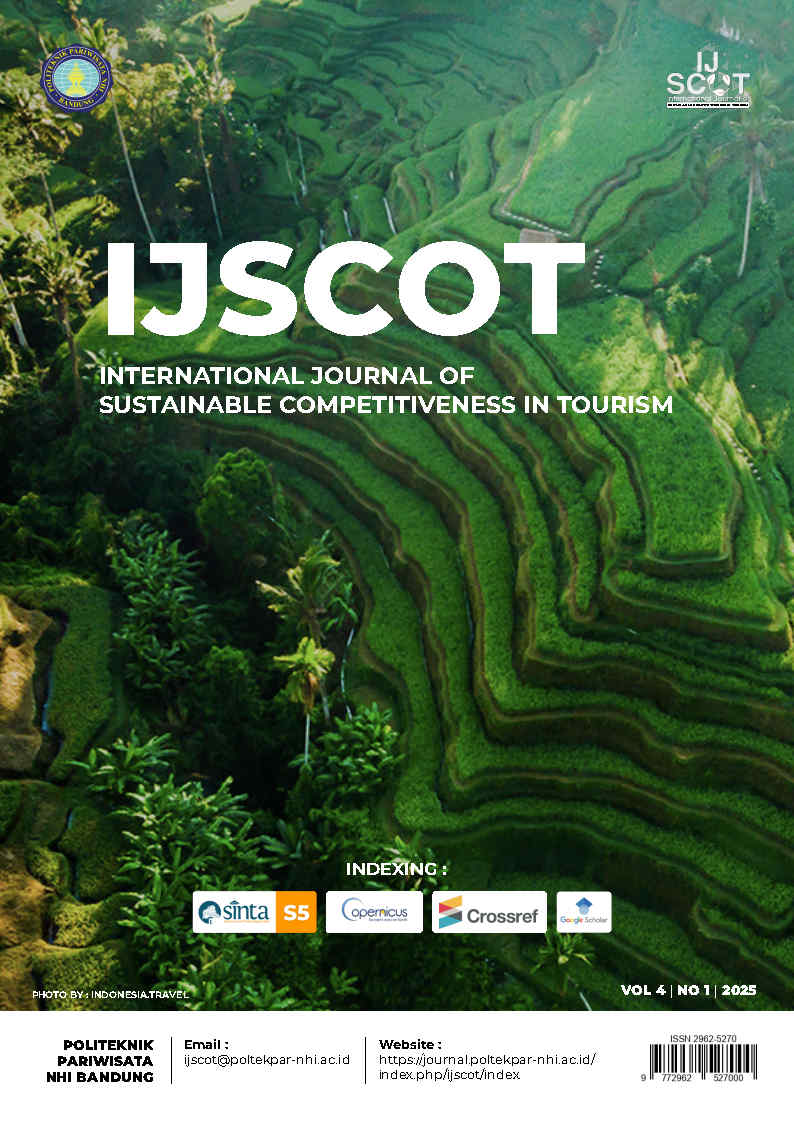Comparative Analysis of Servicescape of Soekarno-Hatta International Airport Terminal 3 and Sanya Phoenix International Airport Terminal 2, Hainan, China on Indonesian Tourist Satisfaction
Abstract
This study compares the servicescape at Soekarno-Hatta International Airport Terminal 3 and
Sanya Phoenix International Airport Terminal 2, Hainan, China, and its impact on Indonesian tourist
satisfaction. This study uses a descriptive quantitative approach with the SEM analysis method
using the Smart PLS 3.2.9 program with sampling using the Non-Probability Sampling Technique.
Data were collected from 390 respondents who had used services at both airports. The analysis
results at Soekarno-Hatta International Airport Terminal 3 show that environmental conditions and
signs, symbols, and artifacts positively influence tourist satisfaction. In contrast, space, layout, and
function elements do not show a significant influence. Meanwhile, at Sanya Phoenix International
Airport Terminal 2, Hainan, China, it shows that environmental conditions, space, layout, and
function elements and signs, symbols, and artifacts do not positively influence tourist satisfaction.
This study provides insight into the importance of airport design and services in improving the
tourist experience. These findings are expected to be a reference for airport managers to improve
the quality of services and facilities offered.
References
image formation: Customers perspective. Journal of Faculty of Tourism and Hotels, Fayoum
University, 1(1), 1–15.
Alfazri, D., & Istiyani, Y. (2024). Pengaruh servicescape terhadap kepuasan penumpang Bandar Udara
Adisutjipto pasca peralihan. Journal of Citizen Research and Development, 1(2), 144–156.
Andriani, N. N. (2021). Pengaruh kualitas pelayanan, promosi, dan servicescape terhadap niat
berkunjung kembali pada Toya Devasya di Kintamani Bangli Bali (Disertasi doktoral). Universitas
Mahasaraswati Denpasar.
Barlow, J. (2006). A new approach to design: A new look at servicescapes. In Designing for the Future.
Bitner, M. J. (1992). Servicescapes: The impact of physical surroundings on customers and employees.
Journal of Marketing, 56(2), 57–71.
Brainnisa, R. (2022). Pengaruh aroma terhadap desain interior. Diakses pada minggu 10 November
2024, dari
https://binus.ac.id/malang/interior/2022/11/04/pengaruh-aroma-terhadap-desain-interior/.
Dewi, N. K. T. U. (2022). Pengaruh lokasi dan servicescape terhadap kepuasan konsumen di Hotel Bintang Bali Resort (Disertasi doktoral). Universitas Mahasaraswati Denpasar.
Dona, R. N., & Kurniadi, D. (2024). Faktor-faktor yang mempengaruhi kepuasan penumpang terhadap
pelayanan bandar udara: Kualitas pelayanan, fasilitas, dan keamanan. Journal of Engineering and
Transportation, 2(1).
Gaspersz, V. (2005). Total quality management. Gramedia.
Indrasari, D. M. (2019). Pemasaran dan kepuasan pelanggan. Unitomo Press.
Kotler, P. (1973). Atmospherics as a marketing tool. Journal of Retailing, 49(4), 48–64.
Kotler, P. (2000). Marketing management: The millennium edition (International ed.). Prentice Hall.
Kuller, R. (2008). Color in architecture: Design for the future.
Lovelock, C., & Wirtz, J. (2011). Manajemen pemasaran jasa: Manusia, teknologi, strategi (Edisi 7 Jilid 1
dan 2). Erlangga.
Luvsandavaajav, O., Narantuya, G., Dalaibaatar, E., & Raffay, Z. (2022). A longitudinal study of
destination image, tourist satisfaction, and revisit intention. Journal of Tourism and Services,
13(24), 128–149.
Mehrabian, A., & Russell, J. A. (1974). An approach to environmental psychology. MIT Press.
Olahstat. (2023). Analisis komparatif antara probability dan nonprobability dalam penelitian
pemasaran. JPAES.
Parasuraman, A., Zeithaml, V. A., & Berry, L. L. (1985). A conceptual model of service quality and its
implications for future research. Journal of Marketing, 49(4), 41–50.
Puspitasari, R. A. (2020). Pengaruh servicescape terhadap kepuasan konsumen: Studi kasus pada
konsumen Angkringan Cak Jo Klithik Ponorogo (Disertasi doktoral). Universitas Muhammadiyah
Ponorogo.
Rasyid, N. M., Ma'amor, H., Ariffin, N., & Achim, N. (2015). Servicescape: Understanding how physical
dimensions influence exhibitors satisfaction in convention centre. Social and Behavioral,
776–782.
Rijae, Z. M., & Magnadi, R. H. (2018). Pengaruh servicescape terhadap kepuasan konsumen (Studi pada
penumpang keberangkatan domestik di Bandara Ahmad Yani Semarang). Diponegoro Journal of
Management, 7(2), 371–381.
Spangenberg, E. R., Crowley, A. E., & Henderson, P. W. (2006). The role of haptic cues in the retail
experience. Journal of Retailing.
Sugiyono. (2018). Metode penelitian kuantitatif. Bandung: Alfabeta.
Sugiyono. (2019). Metode penelitian kuantitatif, kualitatif, dan R&D. Bandung: CV. Alfabeta.
Wilman, M. A., Waseh, H., & Maisaroh, I. (2017). Pengaruh kualitas pelayanan terhadap kepuasan
pelanggan Terminal 3 Bandara Soekarno-Hatta (Disertasi doktoral). Universitas Sultan Ageng
Tirtayasa.
Wulandari, R. R., & Isfiaty, T. (2021). Peran pencahayaan terhadap suasana ruang interior Beehive
Boutique Hotel Bandung. DIVAGATRA-Jurnal Penelitian Mahasiswa Desain, 1(2), 179–191.
Ningsih, S., & Rachmawati, D. (2024). Pengaruh fasilitas ruang tunggu terhadap tingkat kenyamanan
penumpang di Bandar Udara Internasional Zainuddin Abdul Madjid Lombok. Indonesian Journal
of Aviation Science and Engineering, 1(1), 10–10.
Haryati, E. S., & Purbaningrum, C. (2022). Pengaruh servicescape dan kualitas pelayanan customer
service terhadap kepuasan pengguna Bandara Internasional Adi Soemarmo Surakarta. Jurnal
Manajemen Dirgantara, 15(2), 245–250.
Authors

This work is licensed under a Creative Commons Attribution-ShareAlike 4.0 International License.

